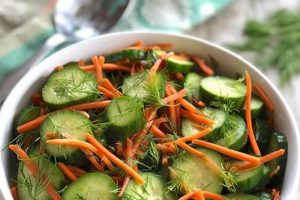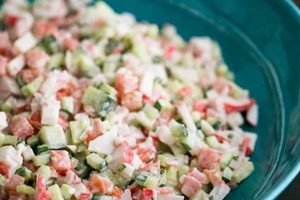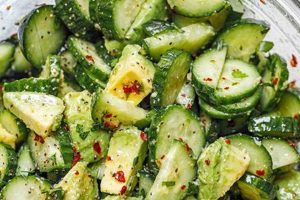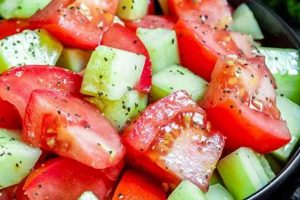The type of acidic ingredient used in a cucumber salad significantly impacts the dish’s overall flavor profile. Different varieties, such as white wine vinegar, apple cider vinegar, rice vinegar, or even lemon juice, each contribute unique notes and levels of acidity. For instance, white wine vinegar lends a crisp, clean taste, while apple cider vinegar adds a touch of sweetness. The choice depends on the desired final flavor, ranging from tangy and bright to subtly sweet and sour.
Balancing acidity with other ingredients like sugar, salt, and herbs is crucial for a well-rounded cucumber salad. Historically, vinegar has played a vital role in preserving food, and its inclusion in salads elevates the simple ingredients while also contributing to their longevity. The acidic element not only brightens the palate but also helps to maintain the crispness of the cucumbers. Selecting the correct acidic component is essential for achieving the perfect harmony of flavors and textures.
This exploration of acidic components provides a foundation for understanding the nuances of cucumber salad preparation. The following sections delve into specific recipes and techniques for creating a variety of delicious cucumber salads, showcasing the versatility of this refreshing dish.
Tips for Enhancing Cucumber Salad with Acid
Achieving the perfect balance of flavors in a cucumber salad relies heavily on the judicious use of acid. These tips offer guidance on selecting and utilizing acidic ingredients to elevate this simple dish.
Tip 1: Consider the Desired Flavor Profile: The chosen acid sets the overall tone. White wine vinegar provides a clean, crisp taste, while apple cider vinegar offers a touch of sweetness. Rice vinegar contributes a mild, slightly sweet flavor, and lemon juice imparts a bright, citrusy tang.
Tip 2: Balance Acidity with Sweetness: A pinch of sugar or a drizzle of honey can temper the sharpness of the acid, creating a more harmonious flavor profile.
Tip 3: Salt Enhances Flavors: Salt not only seasons the salad but also amplifies the other flavors, including the chosen acid. Use it judiciously to achieve a well-rounded taste.
Tip 4: Experiment with Herbs: Fresh herbs like dill, mint, or parsley can complement the acid and add depth of flavor to the salad.
Tip 5: Marinate Briefly for Enhanced Flavor: Allowing the cucumbers to marinate briefly in the acidic dressing helps them absorb the flavors more fully, resulting in a more vibrant and flavorful salad.
Tip 6: Adjust Acidity to Taste: Taste the dressing and adjust the amount of acid as needed. Start with a small amount and gradually add more until the desired level of tartness is achieved.
Tip 7: Consider the Other Ingredients: If the salad includes other acidic ingredients, such as tomatoes or onions, adjust the amount of added acid accordingly to prevent the dish from becoming overly tart.
By carefully considering the type and amount of acid used, one can create a cucumber salad that is both refreshing and flavorful. These tips provide a foundation for experimentation and culinary creativity.
With a solid understanding of the role of acid in cucumber salads, the following section will explore specific recipes and variations, offering practical applications of these principles.
1. Acidity
Acidity plays a crucial role in cucumber salad recipes, impacting both flavor and preservation. The acidic component, often vinegar, provides the characteristic tang that balances the cucumber’s mild flavor. This tartness brightens the palate and creates a refreshing culinary experience. Beyond taste, acidity also contributes to the preservation of the salad’s texture. It inhibits enzymatic activity that can lead to softening, thus maintaining the cucumbers’ desirable crispness. A classic example is the use of white wine vinegar in traditional cucumber salads, where its sharp acidity provides both flavor and textural preservation.
The level of acidity must be carefully calibrated. Too much acid can overpower the other flavors and make the salad unpleasantly tart. Conversely, insufficient acidity can result in a bland, watery salad prone to rapid spoilage. Achieving the optimal balance requires consideration of other ingredients, such as sugar or salt, which can modulate the perceived acidity. For instance, a touch of sugar in a vinegar-based dressing rounds out the sharpness and creates a more harmonious flavor profile. Similarly, salt enhances the other flavors, including the acidity, without directly altering the pH.
Understanding the function of acidity allows for informed decisions when preparing cucumber salads. Selecting the appropriate acidic ingredient, whether vinegar, lemon juice, or another acidic component, is crucial. The choice impacts not only the flavor profile but also the salad’s shelf life. Furthermore, adjusting the acidity level based on the other ingredients and desired outcome ensures a well-balanced and palatable dish. The practical application of this knowledge enables culinary control and consistent results, leading to consistently delicious and refreshing cucumber salads.
2. Type
Vinegar type significantly influences the flavor profile of a cucumber salad. Different vinegars possess unique characteristics derived from their source ingredients and production methods. This diversity allows for a wide range of flavor possibilities, from the crisp, clean taste of white wine vinegar to the mellow sweetness of rice vinegar. The selection of vinegar type should align with the desired outcome, considering the other ingredients and the overall balance of flavors. For example, a delicate cucumber salad with fresh herbs might benefit from the subtle acidity of rice vinegar, while a bolder salad incorporating onions and spices could be enhanced by the robust tang of apple cider vinegar. The interplay between vinegar type and other components is crucial; a harmonious blend elevates the final dish, whereas a clash of flavors can detract from the experience.
Understanding the nuances of various vinegar types empowers informed culinary decisions. White wine vinegar, derived from fermented white wine, offers a bright, crisp acidity that pairs well with delicate flavors. Apple cider vinegar, produced from fermented apple juice, contributes a subtle sweetness and a slightly fruity note. Rice vinegar, made from fermented rice, provides a mild, slightly sweet acidity that complements Asian-inspired dishes. Balsamic vinegar, aged in wooden barrels, delivers a complex, sweet-tart flavor profile suitable for more robust salads. Experimentation with different vinegar types can unlock a spectrum of flavor profiles, allowing for customization and culinary creativity.
Selecting the appropriate vinegar type is paramount for achieving a balanced and flavorful cucumber salad. Careful consideration of the desired flavor profile, the other ingredients, and the overall culinary objective ensures a harmonious and satisfying result. This understanding of vinegar’s multifaceted role in cucumber salad preparation enables both culinary precision and creative exploration. The seemingly simple act of choosing a vinegar type becomes a defining factor in the final dish’s success, underscoring the importance of ingredient awareness and informed culinary practice.
3. Balance
Balance within a cucumber salad hinges on the careful interplay of vinegar’s acidity with other key components: sweetness, saltiness, and the inherent flavors of additional ingredients. Vinegar, while providing essential brightness and tang, can easily overpower the delicate cucumber flavor if not properly balanced. This balance acts as a cornerstone of a successful recipe, preventing excessive tartness and ensuring a harmonious flavor profile. A classic example lies in the traditional combination of vinegar and sugar in cucumber salads. The sugar tempers the vinegar’s sharpness, creating a pleasantly sweet-tart flavor that complements the cucumber’s refreshing nature. This principle extends to the inclusion of salt, which enhances both the perceived sweetness and the acidic notes, further contributing to a balanced overall taste. Ignoring this interplay can lead to a salad that is either overly acidic or bland, highlighting the crucial role balance plays in achieving a desirable outcome.
Achieving this balance requires a nuanced understanding of ingredient interactions. The specific type of vinegar chosen influences the required levels of other components. For instance, a milder rice vinegar necessitates less sugar compared to a sharper white wine vinegar. Similarly, the presence of other ingredients, such as onions or herbs, contributes to the overall flavor profile and must be considered when adjusting the vinegar-sugar-salt ratio. Practical application of this understanding involves tasting and adjusting the dressing throughout the preparation process. A small initial amount of vinegar, followed by incremental additions and taste tests, allows for precise control over the final balance. This iterative approach ensures the salad’s flavor profile aligns with the desired outcome, reflecting a well-balanced and harmonious blend of tastes.
Mastery of balance in cucumber salad preparation distinguishes a truly exceptional dish from a mediocre one. The interplay of vinegar, sugar, salt, and other ingredients creates a complex flavor profile that elevates the simple cucumber to a culinary delight. Understanding these interactions allows for controlled experimentation and customization, enabling culinary creativity and consistently delicious results. Ultimately, achieving balance is essential for maximizing the refreshing and flavorful potential of the cucumber salad, transforming it from a basic side dish to a star component of any meal.
4. Flavor Enhancement
Vinegar’s role in cucumber salad extends beyond mere acidity; it acts as a critical flavor enhancer, amplifying the taste of other ingredients and creating a more complex and satisfying sensory experience. The chemical composition of vinegar, specifically its acetic acid content, interacts with other components in the salad, intensifying their inherent flavors and contributing to a synergistic effect. This interaction is particularly evident with delicate ingredients like cucumbers, where the vinegar’s sharpness accentuates the vegetable’s subtle sweetness and refreshing qualities. Consider the addition of fresh dill to a cucumber salad. While dill possesses its own distinct flavor, the presence of vinegar elevates its herbaceous notes, creating a more pronounced and nuanced taste. This synergistic effect transforms the individual ingredients into a cohesive and flavorful whole, demonstrating vinegar’s crucial role in flavor enhancement.
The mechanism of flavor enhancement involves several factors. Vinegar’s acidity interacts with taste receptors on the tongue, increasing their sensitivity and amplifying the perception of other flavors. Furthermore, vinegar can act as a solvent, extracting flavor compounds from ingredients like herbs and spices, making them more readily available to the palate. For example, marinating sliced cucumbers in a vinegar-based dressing not only infuses them with the dressing’s flavor but also draws out the cucumber’s inherent sweetness, resulting in a more pronounced and complex taste. This practical application highlights the importance of understanding vinegar’s flavor-enhancing properties in culinary practice. Choosing the appropriate type and concentration of vinegar allows for precise control over the final flavor profile, enabling the creation of nuanced and well-balanced cucumber salads.
Flavor enhancement distinguishes a truly exceptional cucumber salad from a merely adequate one. Vinegar’s ability to amplify and harmonize the flavors of other ingredients elevates this simple dish to a culinary experience. Understanding the science behind this phenomenon allows for informed decision-making in recipe development and execution. The practical application of this knowledge enables the creation of cucumber salads with depth, complexity, and balance, transforming a basic side dish into a flavorful and satisfying component of any meal. Furthermore, this understanding encourages culinary experimentation and innovation, opening up possibilities for unique and personalized flavor combinations.
5. Complementary Ingredients
The success of a cucumber salad hinges not only on the correct choice of vinegar but also on the careful selection of complementary ingredients. These additions interact with the vinegar’s acidity, creating a balanced and nuanced flavor profile. Understanding these interactions allows for the creation of a salad that is more than the sum of its parts, transforming simple ingredients into a harmonious and refreshing dish. The following explores key complementary ingredients and their relationship with vinegar in cucumber salad recipes.
- Aromatics
Aromatics, such as onions, garlic, and shallots, contribute pungent notes that contrast and complement the vinegar’s sharpness. Red onion, with its mild bite and vibrant color, is a frequent choice, its sulfurous compounds interacting with the vinegar to create a complex flavor profile. Similarly, a subtle hint of minced garlic can add depth, its pungent allicin complementing the vinegar’s acidity. The choice of aromatic and its quantity must be carefully considered to avoid overpowering the delicate cucumber flavor. A balanced approach allows the aromatics to enhance the overall profile without dominating the salad.
- Herbs
Fresh herbs provide an essential layer of flavor and aroma to cucumber salads. Dill, mint, and parsley are common choices, each offering a unique contribution. Dill’s slightly anise-like flavor pairs well with lighter vinegars like white wine or rice vinegar. Mint adds a refreshing coolness that complements the cucumber’s inherent crispness. Parsley provides a clean, herbaceous note that balances the acidity. The choice of herb should align with the chosen vinegar and other ingredients, creating a synergistic blend of flavors.
- Sweeteners
Sweeteners, including sugar, honey, or maple syrup, play a crucial role in balancing the vinegar’s tartness. A touch of sweetness rounds out the flavor profile, preventing excessive acidity and creating a more harmonious taste. The type and quantity of sweetener should be carefully considered based on the vinegar’s acidity and the desired level of sweetness. For instance, a robust apple cider vinegar may require more sweetener than a delicate rice vinegar. This balance is essential for achieving a well-rounded and palatable salad.
- Spices
Spices, such as black pepper, red pepper flakes, or celery seed, introduce complexity and depth to the cucumber salad. Black pepper adds a subtle warmth and bite, while red pepper flakes contribute a touch of heat. Celery seed offers a unique savory note that complements the cucumber’s flavor. The judicious use of spices can elevate the salad beyond its basic components, creating a more sophisticated and nuanced flavor profile. The choice of spice should complement the other ingredients and the overall flavor profile being sought.
The interplay between vinegar and complementary ingredients defines the character of a cucumber salad. Aromatic additions, fresh herbs, sweeteners, and spices each contribute unique characteristics, interacting with the vinegar to create a complex and balanced flavor profile. Careful consideration of these components and their relationships allows for the creation of cucumber salads that are both refreshing and flavorful, showcasing the versatility of this simple dish. The artful combination of these elements transforms a basic salad into a culinary expression, demonstrating the power of balanced flavors and complementary ingredients.
Frequently Asked Questions about Vinegar in Cucumber Salad
This section addresses common inquiries regarding the use of vinegar in cucumber salad recipes, providing clear and concise information to ensure optimal culinary results.
Question 1: What type of vinegar is best suited for cucumber salad?
The ideal vinegar depends on the desired flavor profile. White wine vinegar offers a crisp, clean taste, while apple cider vinegar adds a touch of sweetness. Rice vinegar provides a mild acidity, and champagne vinegar contributes a delicate, fruity note.
Question 2: How much vinegar should be used in a cucumber salad recipe?
The amount of vinegar depends on the desired level of tartness and the other ingredients. Start with a small amount, approximately 1-2 tablespoons per cucumber, and adjust to taste. Consider the presence of other acidic ingredients, such as tomatoes, which may reduce the required amount of vinegar.
Question 3: Can lemon juice be substituted for vinegar in cucumber salad?
Lemon juice provides a viable alternative to vinegar, offering a bright, citrusy acidity. Use a similar amount of lemon juice as you would vinegar, adjusting to taste. Keep in mind that lemon juice might impart a distinct citrus flavor to the salad.
Question 4: How does vinegar impact the texture of cucumbers in a salad?
Vinegar’s acidity helps maintain the cucumbers’ crispness by inhibiting enzymatic activity that can lead to softening. This preservative effect contributes to the desirable texture of a fresh cucumber salad.
Question 5: How can the sharpness of vinegar be balanced in a cucumber salad?
A touch of sweetness, such as sugar or honey, effectively tempers vinegar’s sharpness. The amount of sweetener needed depends on the vinegar’s acidity and the desired level of sweetness. Taste and adjust accordingly.
Question 6: Does marinating cucumbers in vinegar improve the flavor of the salad?
Briefly marinating cucumbers in a vinegar-based dressing allows them to absorb flavors more fully, enhancing the overall taste and ensuring a more vibrant salad. However, prolonged marinating can lead to excessive softening.
Understanding the role of vinegar and its interaction with other ingredients ensures a balanced and flavorful cucumber salad. Careful consideration of these factors allows for culinary precision and consistently delicious results.
The following section provides a collection of curated cucumber salad recipes, showcasing the practical application of the information presented in this FAQ.
The Essential Role of Vinegar in Cucumber Salad
The exploration of vinegar’s role in cucumber salad recipes reveals its significance beyond mere acidity. Vinegar functions as a flavor enhancer, textural preserver, and a balancing agent, interacting with other ingredients to create a harmonious and refreshing dish. The specific type of vinegar chosen, its concentration, and its interplay with sweetness, salt, and other complementary ingredients dictate the final flavor profile. Understanding these nuances allows for informed culinary decisions, enabling customization and control over the final product. From the crisp brightness of white wine vinegar to the subtle sweetness of rice vinegar, the appropriate selection elevates the simple cucumber to a culinary delight.
Culinary exploration of vinegar’s potential in cucumber salads offers a pathway to both traditional and innovative flavor experiences. The careful consideration of vinegar type, balance, and complementary ingredients empowers culinary creativity and ensures consistently satisfying results. This knowledge fosters a deeper appreciation for the transformative power of vinegar, showcasing its ability to elevate a simple salad to a nuanced and refreshing culinary creation.






